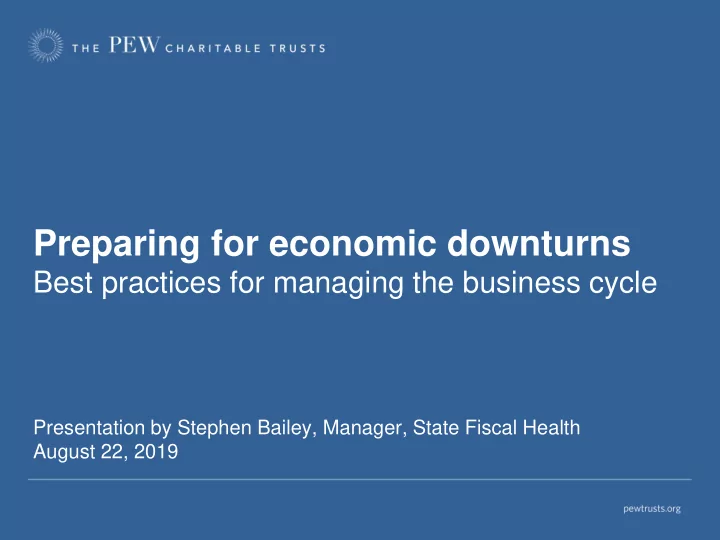

Preparing for economic downturns Best practices for managing the business cycle Presentation by Stephen Bailey, Manager, State Fiscal Health August 22, 2019
About The Pew Charitable Trusts • Conducts research and analysis to improve policy, inform the public, and invigorate civic life. • Established expertise on fiscal management of states, supported by research and experience providing hands-on assistance. • Committed to identifying fiscal best practices and focused on non-partisan, data-driven solutions.
Pew’s research on rainy day funds
48 States Have Formal Rainy Day Funds in Law Statute Constitution Statute + Constitution None
Benefits of a sound rainy day fund policy • Prevents unsustainable budget practices • Lessens the need for program cuts and/or tax increases • Creates predictable levels of available revenue each year • Allows state to focus on important one-time priorities when appropriate • Enhances state credit ratings
Link between rainy day funds and credit rating Rainy day fund size as a percentage of spending 50-State Median AAA-States Lower Rated States 10% 9% 8% 7% 6% 5% 4% 3% 2% 1% 0% Source: Pew analysis of data from National Association of State Budget Officers
State rules for depositing into rainy day funds • Surplus rule: a certain percentage of the end of fiscal year surplus is deposited to the rainy day fund • Forecast error rule: a certain percentage of revenue that exceeds the certified forecast is set aside to the rainy day fund • Static rule: the rainy day fund balance must maintain a certain percentage each year or be repaid within a specified window • Volatility rule (best practice): a certain percentage of revenue growth above a threshold is set aside to the rainy day fund
Rainy day funds are designed to offset volatility Annual percentage change of Pennsylvania’s general fund revenue 12% 10% 8% 6% 4% 2% 0% -2% -4% -6% -8% -10% 2009 2010 2011 2012 2013 2014 2015 2016 2017 2018 Source: Pew analysis of data from PA Department of Revenue
Rainy day funds are designed to offset volatility Annual percentage change of Pennsylvania’s general fund revenue 6-year moving average rule modeled 12% 10% 8% 6% 4% 2% 0% -2% -4% -6% -8% -10% 2009 2010 2011 2012 2013 2014 2015 2016 2017 2018 Total General Fund Change 6 year MA Source: Pew analysis of data from PA Department of Revenue
Rainy day funds are designed to offset volatility Annual percentage change of Pennsylvania’s general fund revenue 4% growth threshold modeled 12% 10% 8% 6% 4% 2% 0% -2% -4% -6% -8% -10% 2009 2010 2011 2012 2013 2014 2015 2016 2017 2018 Total General Fund Change Idaho Rule - 4% Threshold Source: Pew analysis of data from PA Department of Revenue
Each revenue source has its own volatility Percentage change in select general fund tax sources 12% 10% 8% 6% 4% 2% 0% -2% -4% -6% -8% -10% 2009 2010 2011 2012 2013 2014 2015 2016 2017 2018 Total Corporation Taxes Selective Business Total Sales and Use - Total Personal Income - Total Source: Pew analysis of data from PA Department of Revenue
There are volatile components within sources Percentage change in withholding and non-withholding taxes, personal income tax components 15% 10% 5% 0% -5% -10% -15% -20% -25% 2009 2010 2011 2012 2013 2014 2015 2016 2017 2018 Personal Income-withholding Personal Income non-witholding Source: Pew analysis of data from PA Department of Revenue
Savings tied to volatility 9 states saved based on revenue growth prior to Great Recession Volatility based rule in 2007
Savings tied to volatility 21 states now save based on revenue volatility Volatility based rules prior to 2007 Added volatility based rule since 2007
Using volatility rules for more than saving • Creating a framework for identifying non-recurring/one-time revenue is important first step • Vital to deposit some non-recurring revenue into rainy day fund in order to properly manage business cycle • Once reserves are adequate – best practice to place non-recurring revenue toward one-time spending ✓ Capital projects/infrastructure costs ✓ Pay down unfunded liability of pension system ✓ Reduce or refinance state debt ✓ Temporary tax reduction measures or program enhancements
Pew’s technical assistance in states Helping inform rainy day fund policy since Great Recession Pew-supported deposit rule change
Pew’s technical assistance in states Helping inform rainy day fund policy since Great Recession Pew-supported deposit rule change Pew-supported change to fund governance, size, or withdrawal rules
Stephen Bailey The Pew Charitable Trusts sbailey@pewtrusts.org 202-540-6650
Recommend
More recommend